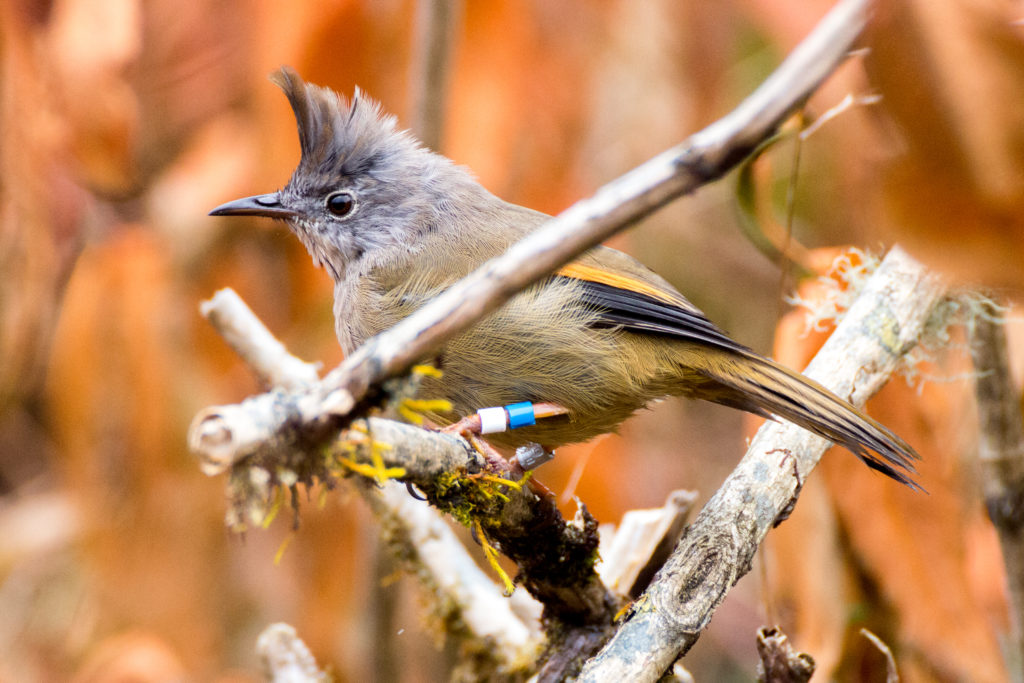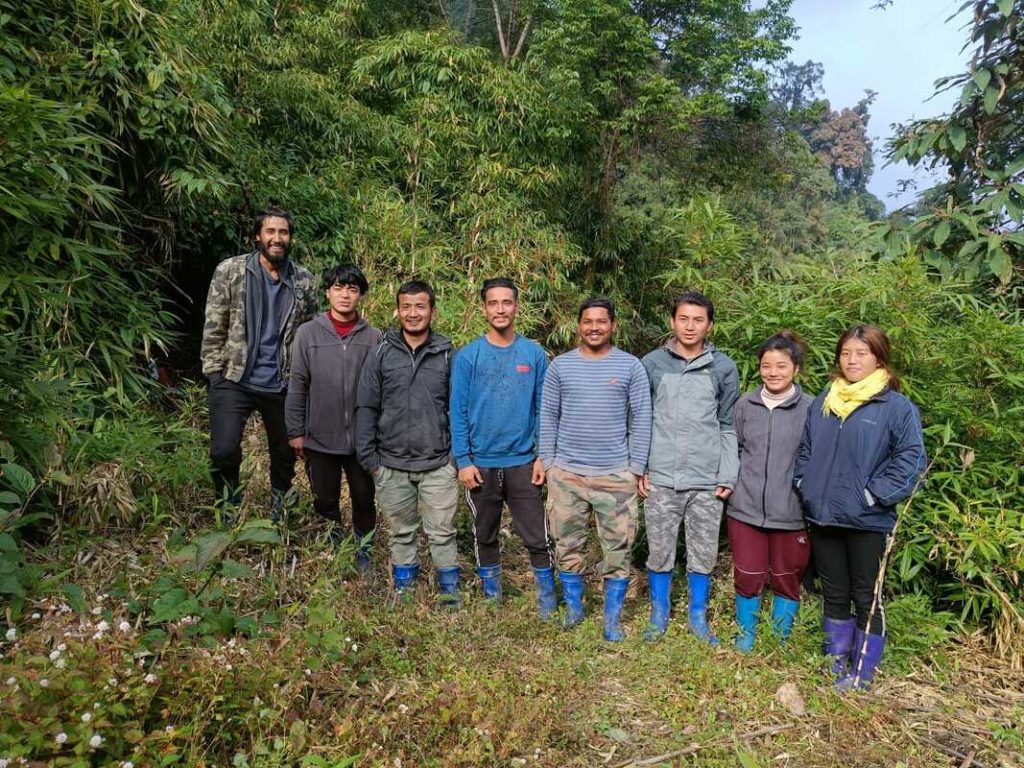One of my favourite sights while working in the hills of Uttarakhand was that of Barn and Red-rumped Swallows nesting in most shops and restaurants I visited in the summer. These nests are usually built using wet mud and are often reused with minor repairs each season. It’s a win-win situation where local business owners believe in the good fortune a successful nest brings and the birds get free lodging and reasonable safety from predators. To keep patrons (and their food) safe from bird droppings, shopkeepers attach a small piece of cardboard below the nest. Most shopkeepers will also keep the shutters partly open post work hours so that parents can move in and out and tend to the young. On learning that I study birds, these shopkeepers would keep me updated as to the daily happenings at the nests in their shops. When the eggs had been laid, when they hatched and when the fledglings finally learnt to fly. I guess this is a future citizen science project waiting to happen.
 A Barn Swallow and fledglings nesting in a roadside dhaba near Nainital
A Barn Swallow and fledglings nesting in a roadside dhaba near Nainital
This is how my love for birds and research took shape..
Ever since I can remember I have had an affinity towards animals and nature. Growing up in the city of Mumbai I spent a lot of time at the zoo and in nearby gardens. I also used to look forward to visiting my grandparents in Kerala and meeting the local temple elephants. In hindsight, I understand the complexity of keeping wild animals in captivity, but it was a learning experience, nonetheless. As for my interest in birds, I think I have been a bird watcher from childhood. Not in the traditional sense though, I couldn’t identify them, but I had my own names for birds that weren’t crows, sparrows or pigeons. It was only around the age of 14 when my grandfather gifted me his old pair of binoculars and Salim Ali’s Handbook of Indian Birds that I started making a concerted effort to identify these birds.
Growing up, I was barely aware of research in the field of ecology, so my long-standing aspiration was to be a veterinarian for wild animals. However, I did pretty terribly on the entrance exams post high school and ended up doing a regular Bachelors in Zoology at SIES college, Mumbai. My enthusiastic professor Dr Aditya Akerkar used to take us on multiple field trips and have us interact with people in the field of natural history, ecology, and conservation and it was thanks to him I realised that this was something I could see myself doing. To get a better understanding of the field I started volunteering and interning on various projects until I found myself doing a master’s degree in Wildlife Biology and Conservation at NCBS Bangalore (fortunately my entrance exam skills had improved by then). With the research skills the program imparted I looked at bird habitat relationships in the western Himalayas for my master’s dissertation (under the guidance of Dr Ghazala Shahabuddin) and have continued studying birds ever since.
I am currently doing my PhD with Dr Umesh Srinivasan at the Centre for Ecological Sciences in the Indian Institute of Science where I am trying to understand the drivers of altitudinal migration in birds. In the Himalayas, nearly 70% of bird species show some seasonal movement between higher-elevation breeding grounds and lower-elevation wintering grounds. Additionally, most altitudinally migrating birds here are insectivores, which means they mostly feed on invertebrates. On the other hand, a significant fraction of species are resident at higher elevations. Winters at high altitudes in the Himalayas can be very severe both in terms of cold temperatures and scarcity of food resources. At higher elevations, arthropods often lie dormant to escape the harsh winter but then synchronously emerge during spring, causing a peak in abundance in summer. My research will aim to understand why some species prefer to migrate while others prefer to stay back. Are altitudinally migrating birds tracking temperatures, arthropod prey abundances or a combination of both? This research is being conducted in Eaglenest Wildlife Sanctuary, Arunachal Pradesh which is a part of the Eastern Himalaya Global Biodiversity Hotspot and home to 550 breeding bird species. In addition to being highly diverse the sanctuary has an easily accessible elevation gradient that goes from 800m to 3300m above sea level.
 A uniquely ringed and colour banded Stripe-throated Yuhina
A uniquely ringed and colour banded Stripe-throated Yuhina
I love what I do because…
Apart from the obvious answer of spending time watching birds in the forest, I think my favourite aspect of the work I do is learning new details about bird natural history. So little is known about most Indian species that every small observation I make of a species feels like something new. I also enjoy discussing these observations with other bird researchers and coming up with hypotheses to explain similarities and differences in our findings.
Challenges I faced…
I have been one of the fortunate few to have not faced too many significant challenges in my work (so far). Smaller challenges have been generally internal and existential in nature. The question I often ask myself is why am I in this field? Is it just self-indulgence or do I really believe that I am making a difference towards the conservation of the species I study? Given the times we are living in, I often wonder whether my ecological research will actually help these species survive the turn of this century. Maintaining a high morale and keeping myself motivated is a challenge I often find myself having to work through.
 Our very talented field team without whom none of our work in Eaglenest would be possible
Our very talented field team without whom none of our work in Eaglenest would be possible
My advice to young researchers is…
I must admit I feel nowhere near the position to be giving advice. If one is really interested in my opinion I would say.
- The health and safety of your study species should be your priority. Do not do anything that could jeopardise that (unless strongly justified)
- Don’t be afraid to talk to peers and seniors or even ask for help. I have found the ornithology and ecology community to be very welcoming and eager to help/offer advice. Additionally, be open to collaborating with others, don’t let your ego come in the way
- If you are of the academic bent, keep up to date with the literature. Ornithology is a popular field with many interesting studies coming from around the world. Read and understand these papers and try to write a small summary for yourself. This will help you make connect ideas and come up with interesting questions of your own
- If your research involves fieldwork, always be respectful of local communities. Without local support most field-based projects would fall flat. Bad behaviour by one researcher can make it difficult for future researchers.
Tarun Menon
[email protected]
PhD Student
Centre for Ecological Sciences, Indian Institute of Science
Website: https://tarunmenon.wordpress.com/
Google Scholar Profile
Instagram: @tarunmenon15


Wonderful
amazing Tarun
Thanks for sharing your ideas with all of us. Hope you find all your answers what you are seeking from nature.
I meet you at Sessni during my tour on April, 2022.
Thank you for your information, guidance.
I found your Interest in birds have taken you to the right choice of studies which you have pursued growing up that’s really great. Your sense of observations and interests in birds which you have persued should be encouraged by a lot more youngsters etc.I too am a bird lover who likes to photograph them. And observe them making their nests.
Your journey made a very good impression on me.
Keep up the good work.
That’s a beautiful write up Tarun. You s to m to be living your dream while bringing insight into lives of these Himalayan birds.. keep up the good work 👍😇
Hi Tarun!
So glad to come across this article and a fellow bird lover who aimed high to convert his zest for birdwatching into a full fledged career. The blogs teases the glimpse of what your PhD course looks like and seems to promise an interesting research. Looking forward to many more blogs and insights to learn.
Thank you everyone for your kind words of support! This inspires me to write more about my experiences with our country’s beautiful birdlife 🙂
Hi Tarun, fascinating to read about your journey. Met your mom Tara today in Nagaland and she told me all about your work. I’d love to connect on LinkedIn and follow your journey.
https://www.linkedin.com/in/monisha-krishna-7bba761a2